2006 SUBARU IMPREZA airbag
[x] Cancel search: airbagPage 29 of 365

1-2 Seat, seatbelt and SRS airbags
Seat, seatbelt and SRS airbagsFront seats
Never adjust the seat while driv-
ing to avoid the possibility of loss
of vehicle control and of personal
injury.
Before adjusting the seat, make
sure the hands and feet of rear
seat passengers are clear of the
adjusting mechanism.
Seatbelts provide maximum re-
straint when the occupant sits
well back and upright in the seat.
To reduce the risk of sliding under
the seatbelt in a collision, the
front seatbacks should be always
used in the upright position while
the vehicle is running. If the front
seatbacks are not used in the up-
right position in a collision, the
risk of sliding under the lap belt
and of the lap belt sliding up over
the abdomen will increase, and
both can result in serious internal
injury or death.
The SRS airbags deploy with con-
siderable speed and force. Occu-
pants who are out of proper posi-
tion when the SRS airbag deploys
could suffer very serious injuries.
Because the SRS airbag needs
enough space for deployment, the
driver should always sit upright
and well back in the seat as far
from the steering wheel as practi-
cal while still maintaining full ve-
hicle control and the front passen-
ger should move the seat as far
back as possible and sit upright
and well back in the seat.
100082
Put children aged 12 and under in
the rear seat properly restrained at
all times. The SRS airbag deploys
with considerable speed and force
and can injure or even kill children,
especially if they are 12 years of age
and under and are not restrained or
improperly restrained. Because chil-
dren are lighter and weaker than
adults, their risk of being injured
from deployment is greater. Conse-
quently, we strongly recommend
that ALL children (including those in
child seats and those that have out-
grown child restraint devices) sit in
the REAR seat properly restrained
at all times in a child restraint device
or in a seatbelt, whichever is appro-
priate for the child s age, height and
weight. Secure ALL types of child
restraint devices (including forward
facing child seat) in the REAR seats
at all times.
NEVER INSTALL A REARWARD
FACING CHILD SEAT IN THE FRONT
SEAT. DOING SO RISKS SERIOUS
INJURY OR DEATH TO THE CHILD
BY PLACING THE CHILD S HEAD
TOO CLOSE TO THE SRS AIRBAG.
Page 30 of 365
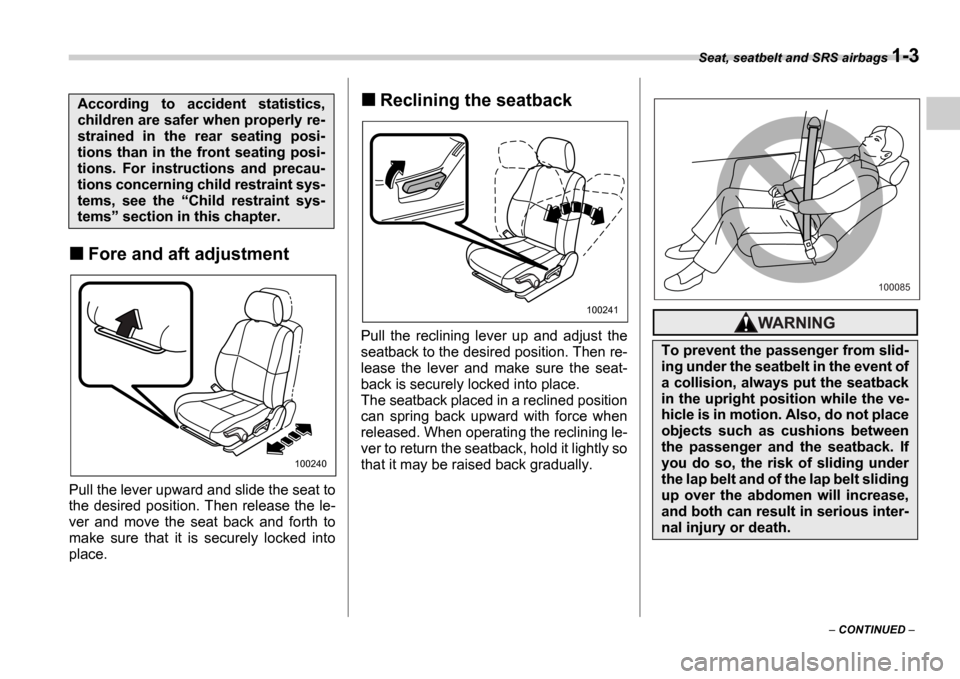
Seat, seatbelt and SRS airbags 1-3
CONTINUED
Fore and aft adjustment
Pull the lever upward and slide the seat to
the desired position. Then release the le-
ver and move the seat back and forth to
make sure that it is securely locked into
place.
Reclining the seatback
Pull the reclining lever up and adjust the
seatback to the desired position. Then re-
lease the lever and make sure the seat-
back is securely locked into place.
The seatback placed in a reclined position
can spring back upward with force when
released. When operating the reclining le-
ver to return the seatback, hold it lightly so
that it may be raised back gradually.
According to accident statistics,
children are safer when properly re-
strained in the rear seating posi-
tions than in the front seating posi-
tions. For instructions and precau-
tions concerning child restraint sys-
tems, see the Child restraint sys-
tems section in this chapter.
100240
100241
To prevent the passenger from slid-
ing under the seatbelt in the event of
a collision, always put the seatback
in the upright position while the ve-
hicle is in motion. Also, do not place
objects such as cushions between
the passenger and the seatback. If
you do so, the risk of sliding under
the lap belt and of the lap belt sliding
up over the abdomen will increase,
and both can result in serious inter-
nal injury or death.
100085
Page 31 of 365
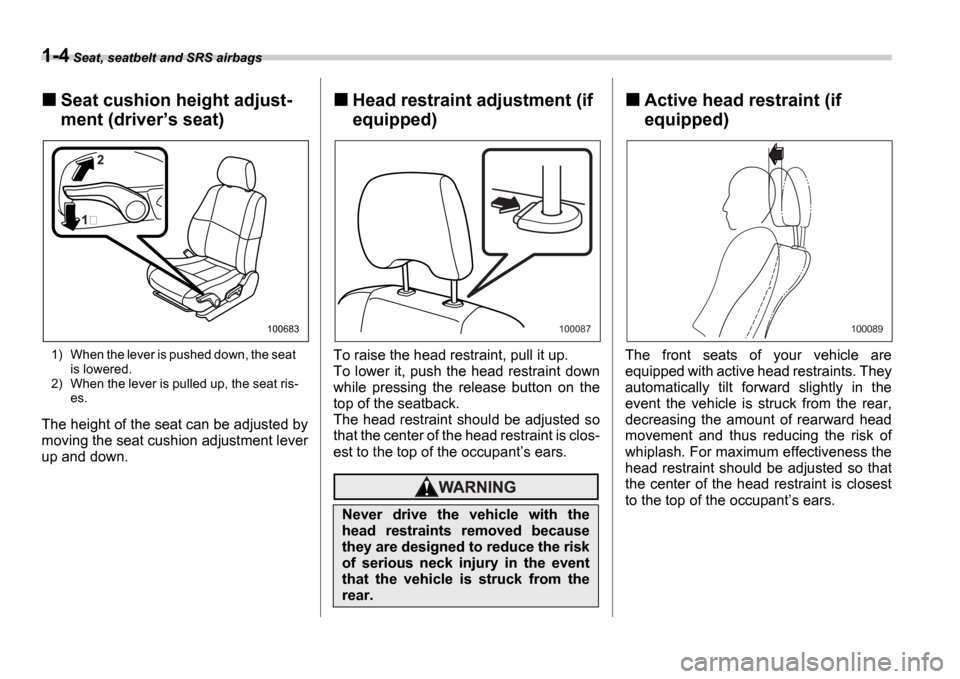
1-4 Seat, seatbelt and SRS airbags
Seat cushion height adjust-
ment (driver s seat)
1) When the lever is pushed down, the seat is lowered.
2) When the lever is pulled up, the seat ris- es.
The height of the seat can be adjusted by
moving the seat cushion adjustment lever
up and down.
Head restraint adjustment (if
equipped)
To raise the head restraint, pull it up.
To lower it, push the head restraint down
while pressing the release button on the
top of the seatback.
The head restraint should be adjusted so
that the center of the head restraint is clos-
est to the top of the occupant s ears.
Active head restraint (if
equipped)
The front seats of your vehicle are
equipped with active head restraints. They
automatically tilt forward slightly in the
event the vehicle is struck from the rear,
decreasing the amount of rearward head
movement and thus reducing the risk of
whiplash. For maximum effectiveness the
head restraint should be adjusted so that
the center of the head restraint is closest
to the top of the occupant s ears.
2
100683
Never drive the vehicle with the
head restraints removed because
they are designed to reduce the risk
of serious neck injury in the event
that the vehicle is struck from the
rear.
100087100089
Page 32 of 365
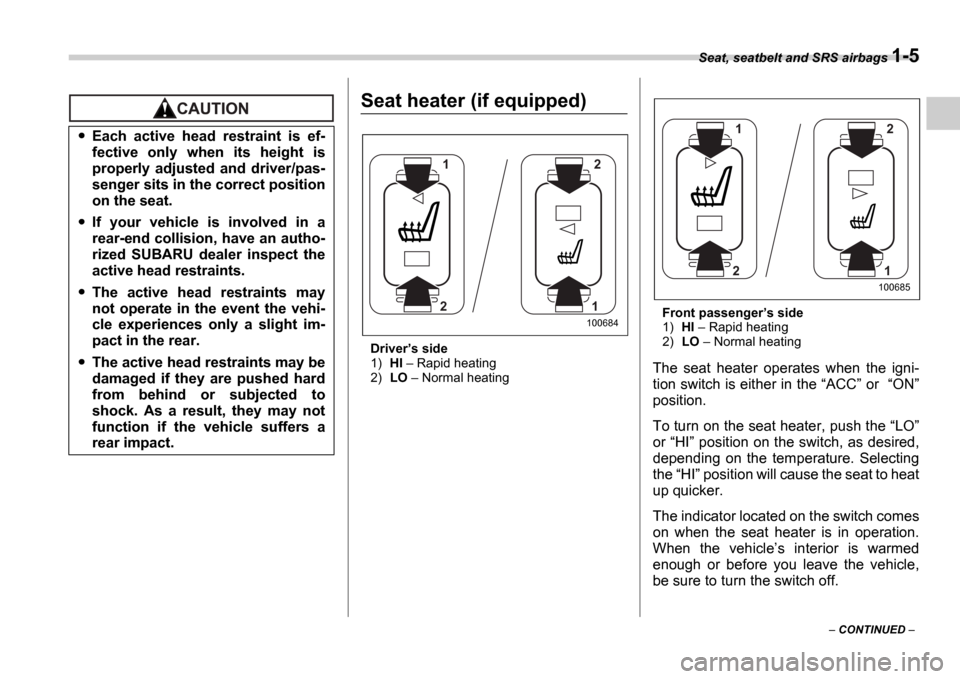
Seat, seatbelt and SRS airbags 1-5
CONTINUED
Seat heater (if equipped)
Driver s side
1) HI Rapid heating
2) LO Normal heating Front passenger
s side
1) HI Rapid heating
2) LO Normal heating
The seat heater operates when the igni-
tion switch is either in the ACC or ON
position.
To turn on the seat heater, push the LO
or HI position on the switch, as desired,
depending on the temperature. Selecting
the HI position will cause the seat to heat
up quicker.
The indicator located on the switch comes
on when the seat heater is in operation.
When the vehicle s interior is warmed
enough or before you leave the vehicle,
be sure to turn the switch off.
Each active head restraint is ef-
fective only when its height is
properly adjusted and driver/pas-
senger sits in the correct position
on the seat.
If your vehicle is involved in a
rear-end collision, have an autho-
rized SUBARU dealer inspect the
active head restraints.
The active head restraints may
not operate in the event the vehi-
cle experiences only a slight im-
pact in the rear.
The active head restraints may be
damaged if they are pushed hard
from behind or subjected to
shock. As a result, they may not
function if the vehicle suffers a
rear impact.
1
2 2
1
100684
1
2 2
1
100685
Page 33 of 365
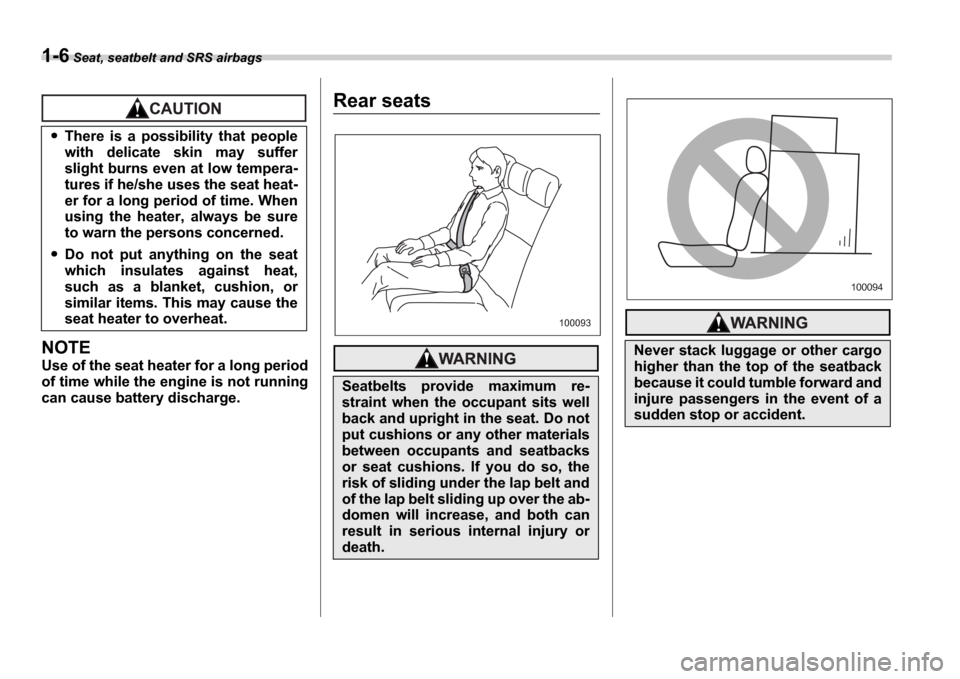
1-6 Seat, seatbelt and SRS airbags
NOTE
Use of the seat heater for a long period
of time while the engine is not running
can cause battery discharge.
Rear seats
There is a possibility that people
with delicate skin may suffer
slight burns even at low tempera-
tures if he/she uses the seat heat-
er for a long period of time. When
using the heater, always be sure
to warn the persons concerned.
Do not put anything on the seat
which insulates against heat,
such as a blanket, cushion, or
similar items. This may cause the
seat heater to overheat.
Seatbelts provide maximum re-
straint when the occupant sits well
back and upright in the seat. Do not
put cushions or any other materials
between occupants and seatbacks
or seat cushions. If you do so, the
risk of sliding under the lap belt and
of the lap belt sliding up over the ab-
domen will increase, and both can
result in serious internal injury or
death.
100093
Never stack luggage or other cargo
higher than the top of the seatback
because it could tumble forward and
injure passengers in the event of a
sudden stop or accident.
100094
Page 34 of 365
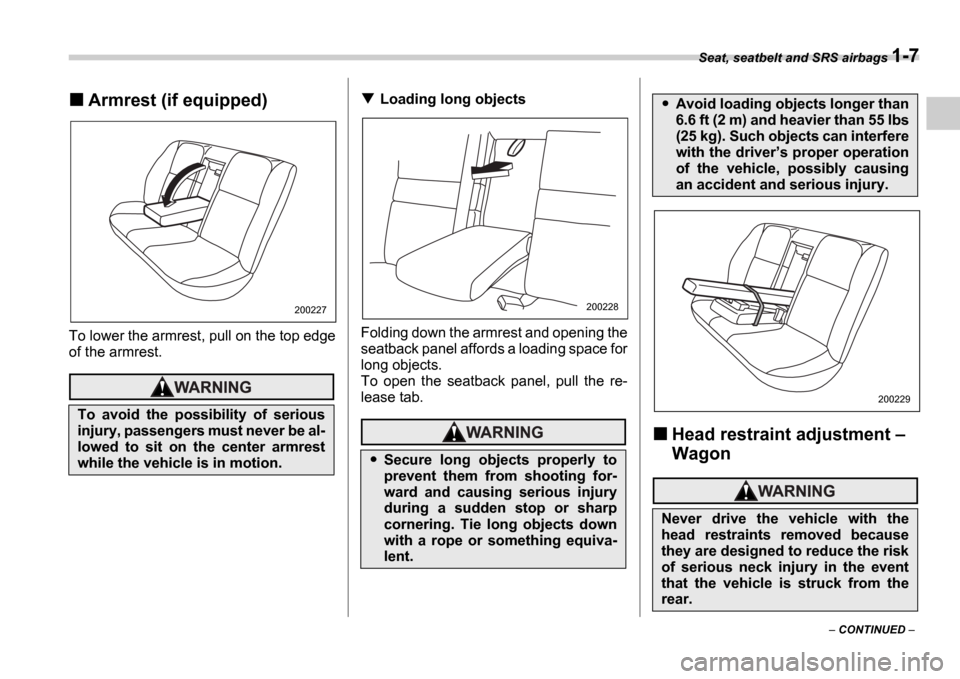
Seat, seatbelt and SRS airbags 1-7
CONTINUED
Armrest (if equipped)
To lower the armrest, pull on the top edge
of the armrest.
Loading long objects
Folding down the armrest and opening the
seatback panel affords a loading space for
long objects.
To open the seatback panel, pull the re-
lease tab.
Head restraint adjustment
Wagon
To avoid the possibility of serious
injury, passengers must never be al-
lowed to sit on the center armrest
while the vehicle is in motion.
200227
Secure long objects properly to
prevent them from shooting for-
ward and causing serious injury
during a sudden stop or sharp
cornering. Tie long objects down
with a rope or something equiva-
lent.
200228
Avoid loading objects longer than
6.6 ft (2 m) and heavier than 55 lbs
(25 kg). Such objects can interfere
with the driver s proper operation
of the vehicle, possibly causing
an accident and serious injury.
Never drive the vehicle with the
head restraints removed because
they are designed to reduce the risk
of serious neck injury in the event
that the vehicle is struck from the
rear.
200229
Page 35 of 365
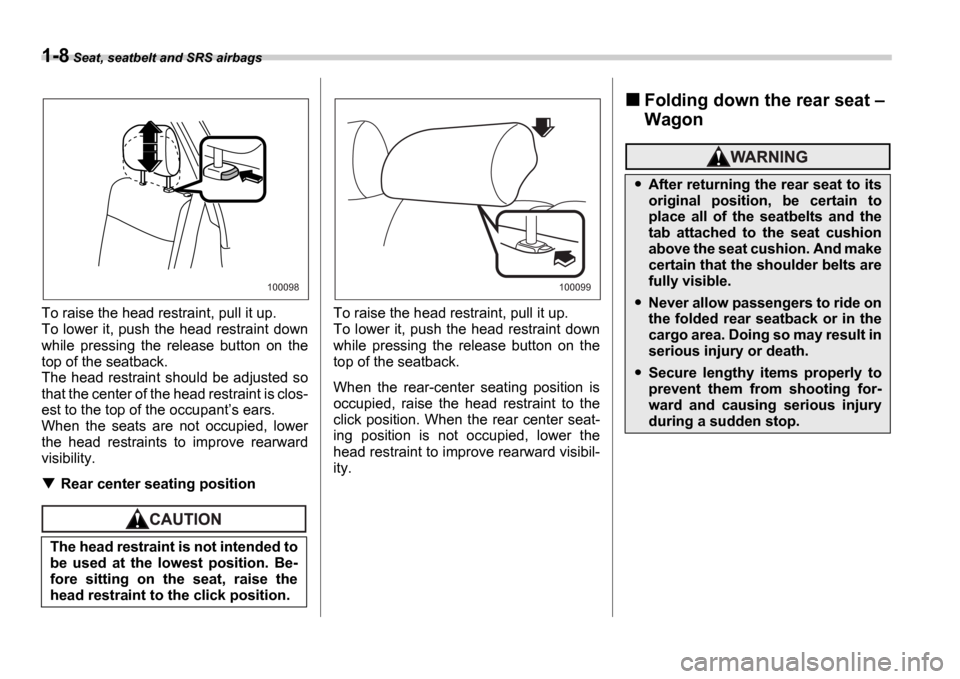
1-8 Seat, seatbelt and SRS airbags
To raise the head restraint, pull it up.
To lower it, push the head restraint down
while pressing the release button on the
top of the seatback.
The head restraint should be adjusted so
that the center of the head restraint is clos-
est to the top of the occupant s ears.
When the seats are not occupied, lower
the head restraints to improve rearward
visibility.
Rear center seating position
To raise the head restraint, pull it up.
To lower it, push the head restraint down
while pressing the release button on the
top of the seatback.
When the rear-center seating position is
occupied, raise the head restraint to the
click position. When the rear center seat-
ing position is not occupied, lower the
head restraint to improve rearward visibil-
ity.
Folding down the rear seat
Wagon
The head restraint is not intended to
be used at the lowest position. Be-
fore sitting on the seat, raise the
head restraint to the click position.
100098100099
After returning the rear seat to its
original position, be certain to
place all of the seatbelts and the
tab attached to the seat cushion
above the seat cushion. And make
certain that the shoulder belts are
fully visible.
Never allow passengers to ride on
the folded rear seatback or in the
cargo area. Doing so may result in
serious injury or death.
Secure lengthy items properly to
prevent them from shooting for-
ward and causing serious injury
during a sudden stop.
Page 36 of 365
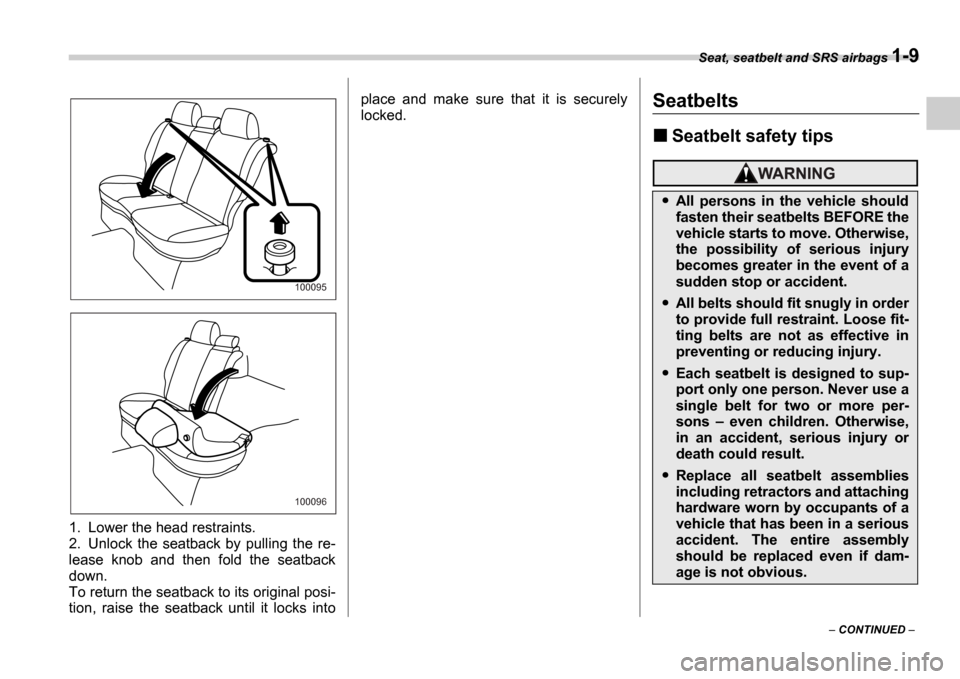
Seat, seatbelt and SRS airbags 1-9
CONTINUED
1. Lower the head restraints.
2. Unlock the seatback by pulling the re-
lease knob and then fold the seatback
down.
To return the seatback to its original posi-
tion, raise the seatback until it locks into place and make sure that it is securely
locked.
Seatbelts
Seatbelt safety tips
100095
100096
All persons in the vehicle should
fasten their seatbelts BEFORE the
vehicle starts to move. Otherwise,
the possibility of serious injury
becomes greater in the event of a
sudden stop or accident.
All belts should fit snugly in order
to provide full restraint. Loose fit-
ting belts are not as effective in
preventing or reducing injury.
Each seatbelt is designed to sup-
port only one person. Never use a
single belt for two or more per-
sons
even children. Otherwise,
in an accident, serious injury or
death could result.
Replace all seatbelt assemblies
including retractors and attaching
hardware worn by occupants of a
vehicle that has been in a serious
accident. The entire assembly
should be replaced even if dam-
age is not obvious.